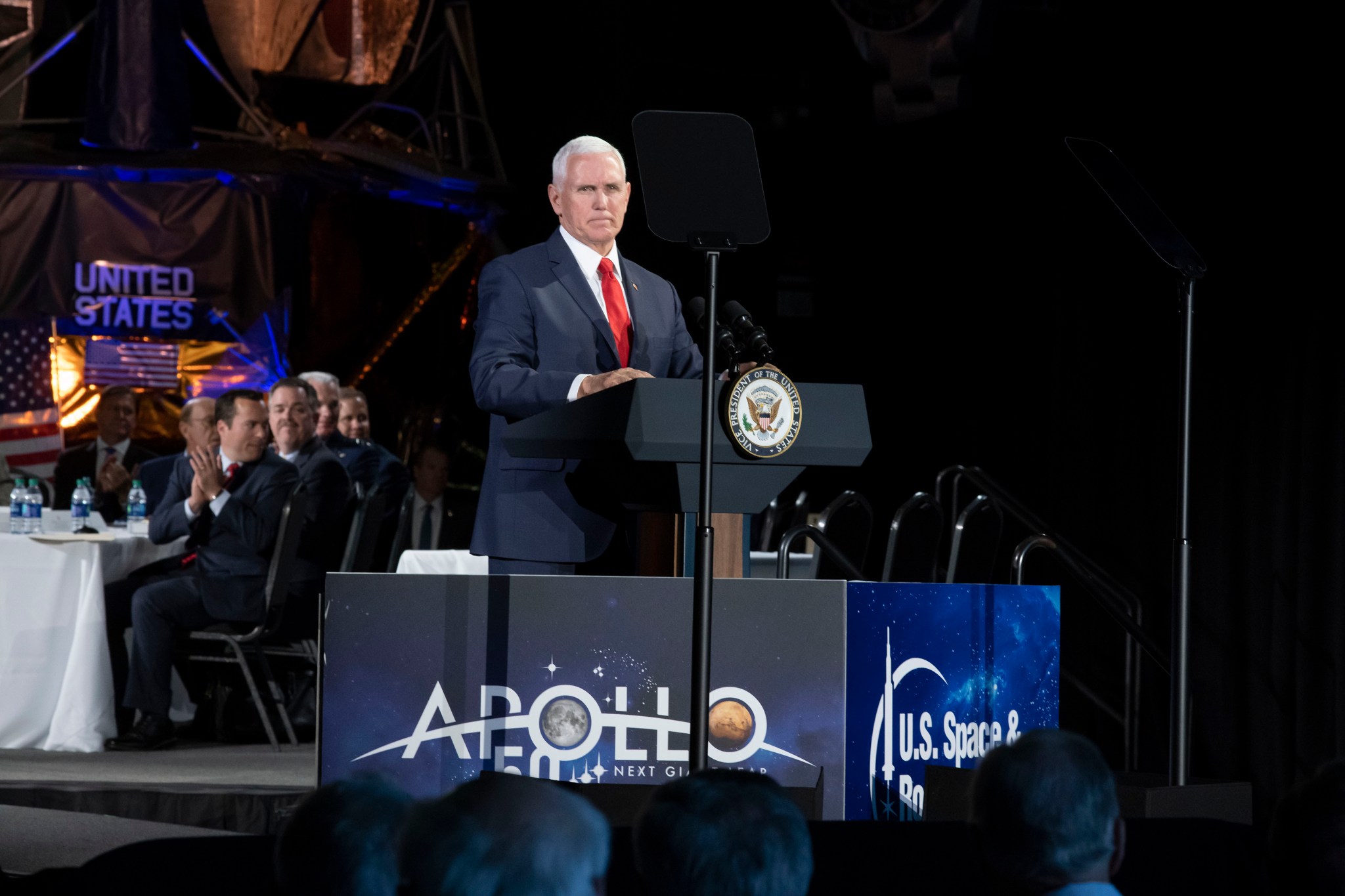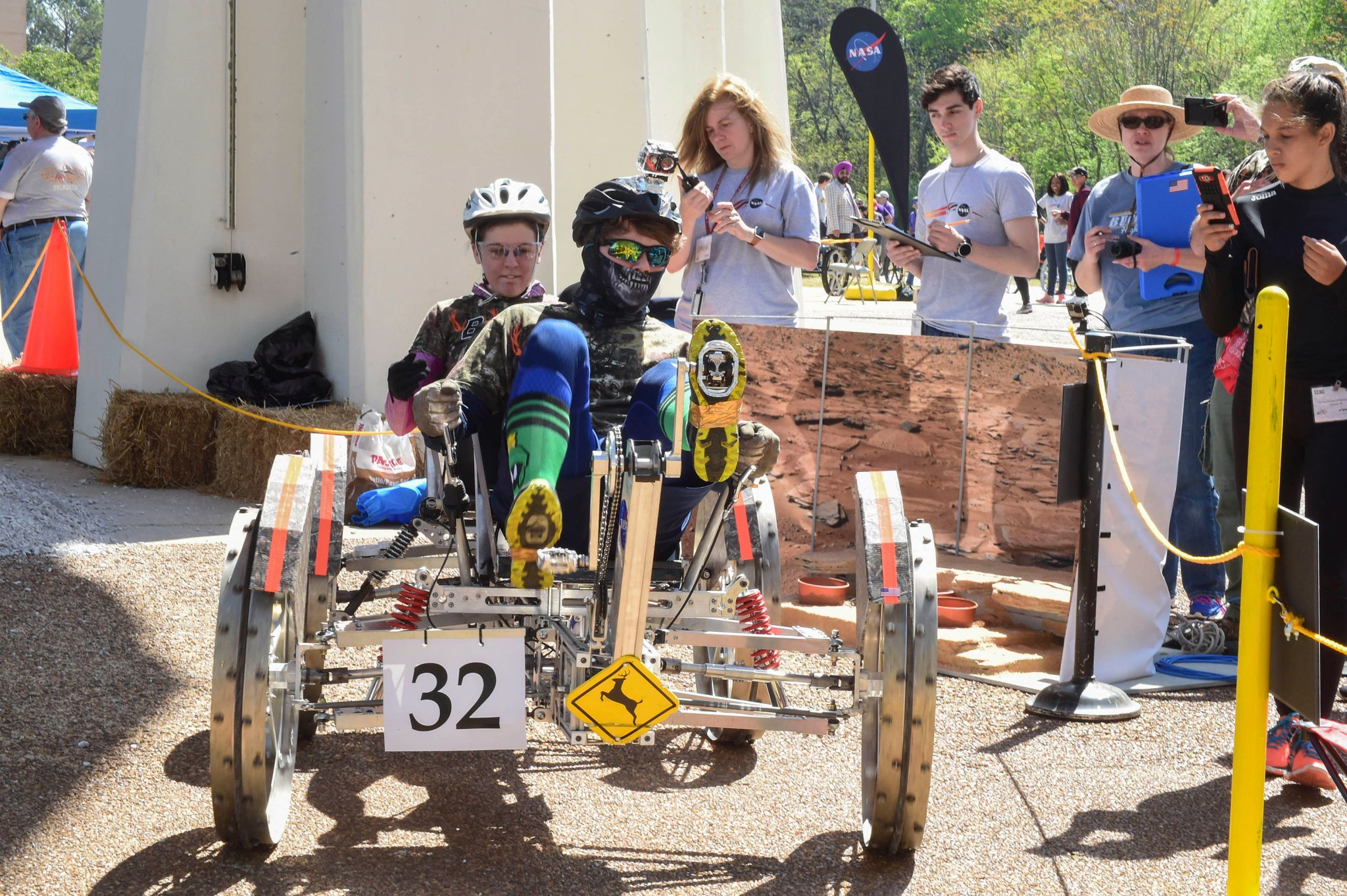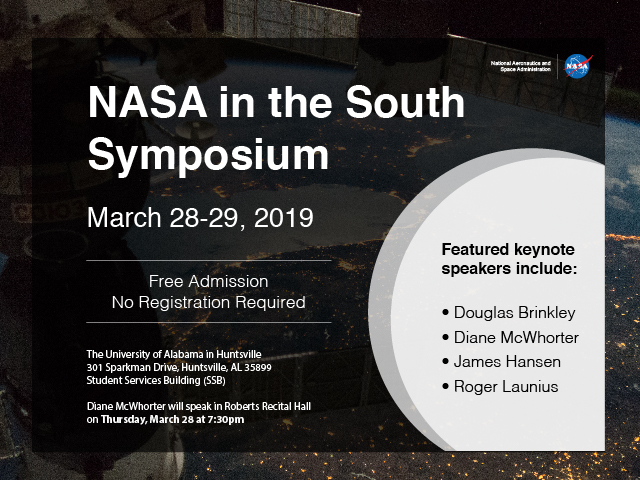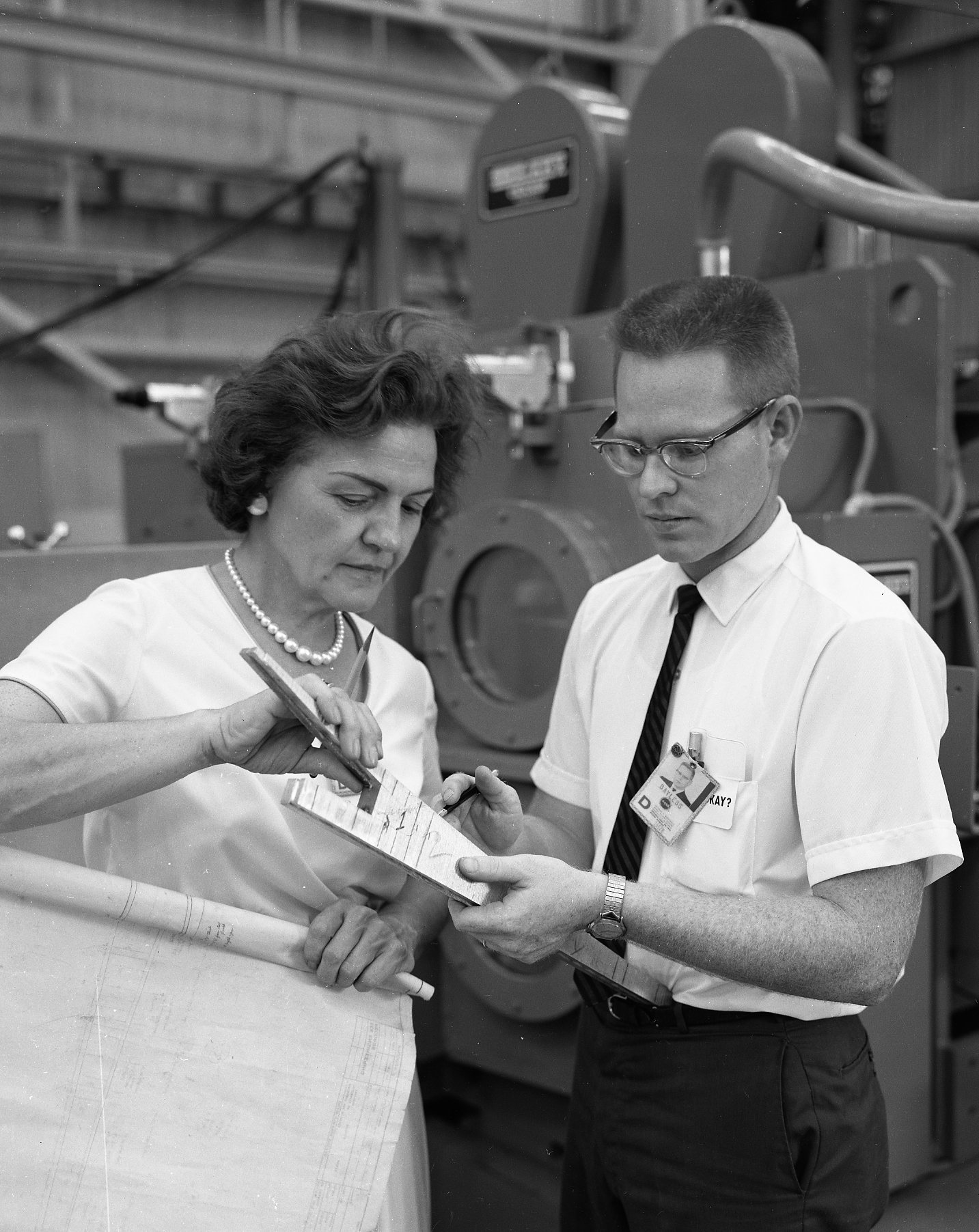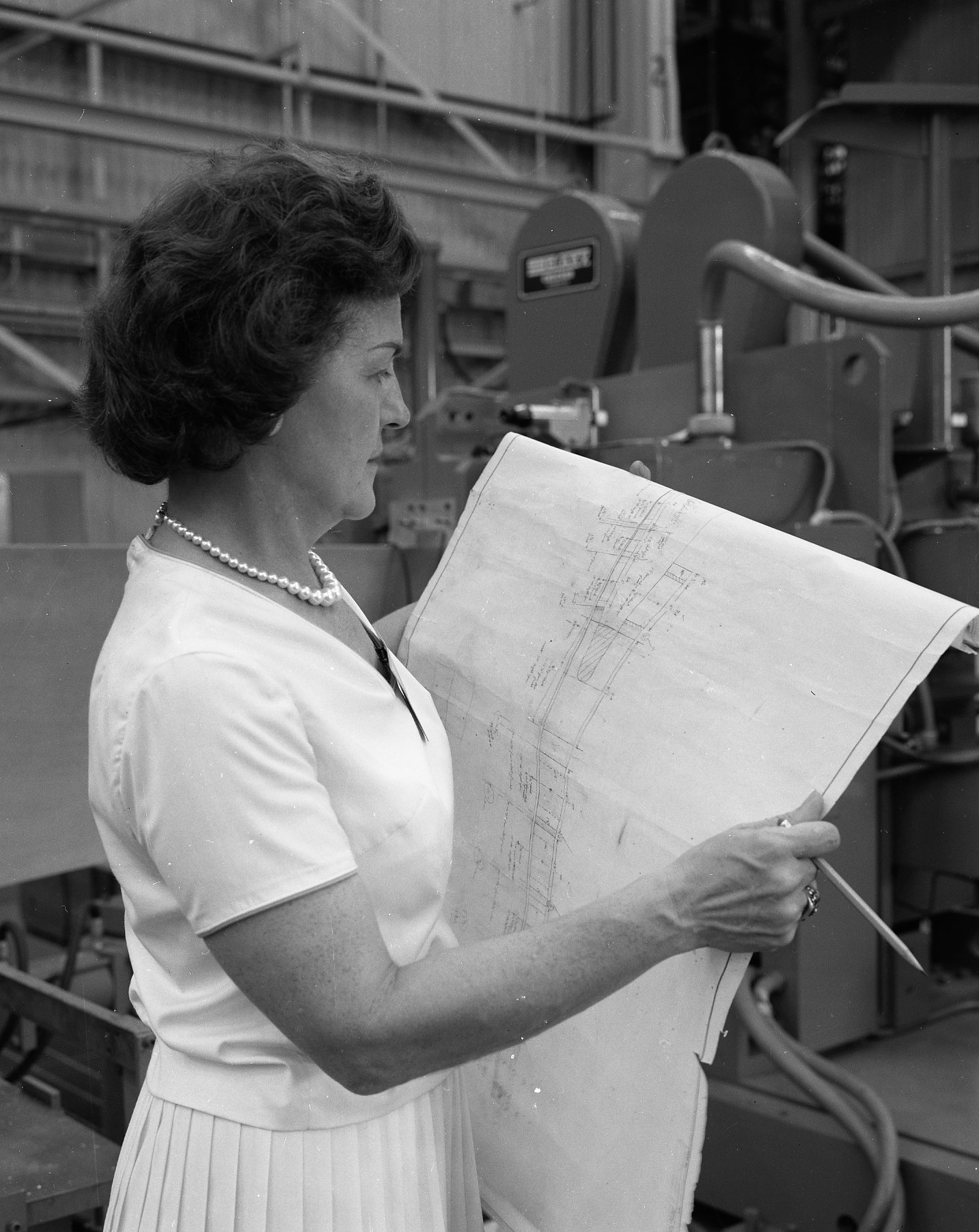In This Week’s Star
- Vice President Pence to NASA, Nation: ‘Return Americans to Moon’ in Next Five Years
- NASA Deputy Administrator Jim Morhard Visits Marshall
- Marshall Team Finalizes Key Rocket Joint Assembly for Space Launch System
- 50 Years After Apollo, NASA Celebrates 25 Years of Student Rover Challenge
- How NASA Engineer Julie Bassler Uses Her Farming Roots to Build NASA’s First Deep Space Rocket
- Marshall and UAH to Host NASA in the South Symposium March 28-29
- Honoring the Women of Marshall: Margaret W. ‘Hap’ Brennecke
- Marshall’s Martin Weisskopf Talks Development and Discoveries of Chandra X-Ray Observatory
- OSIRIS-REx and Fermi Highlighted on ‘This Week @NASA’
- This Week in NASA History: Installation of S-IC-D in Vertical Assembly Building at Michoud – March 24, 1965
Vice President Pence to NASA, Nation: ‘Return Americans to Moon’ in Next Five Years
By Rick Smith
During his visit to Huntsville March 26, Vice President Mike Pence praised the hard work and dedication of NASA’s Marshall Space Flight Center team members – and at a meeting of the National Space Council, delivered an historic challenge to NASA and its spacefaring partners to return American astronauts to the Moon within the next five years.
Opening the fifth meeting of the National Space Council, Pence praised ongoing work at Marshall and nationwide to build, test and prepare to fly the Space Launch System, the most powerful rocket in history. He then charged NASA and its partners with accelerating the timetable for achieving the goals of Space Policy Directive-1, which directs NASA to return to the Moon in preparation for crewed missions to Mars and beyond.
“It is the stated policy of this administration … to return American astronauts to the Moon within the next five years,” Pence emphasized to council members, including NASA Administrator Jim Bridenstine, at the meeting’s site, the U.S. Space & Rocket Center. “The first woman and the next man on the Moon will both be American astronauts, launched by American rockets from American soil.”
That challenge accelerates plans to return explorers to the lunar surface from as early as 2028 to a new goal of 2024 – a new urgency Pence said would require “renewed focus and a relentless will to achieve our mission.” Both, he added, are “abundant” in northern Alabama.
“Urgency has always been in the DNA of Rocket City,” he said. “The men and women of the Marshall Space Flight Center know exactly what it takes to be first in space, because you’ve been doing it for generations.”
He urged NASA to consider “every available option and platform to meet our goals, including industry, government and the entire American space enterprise.”
“For more than 60 years, Huntsville, Alabama, has built the finest rocket propulsion systems in the world,” he added. “And we want to ensure it remains that way for the next 60 years.” [Read the complete text of the Vice President’s remarks here.]
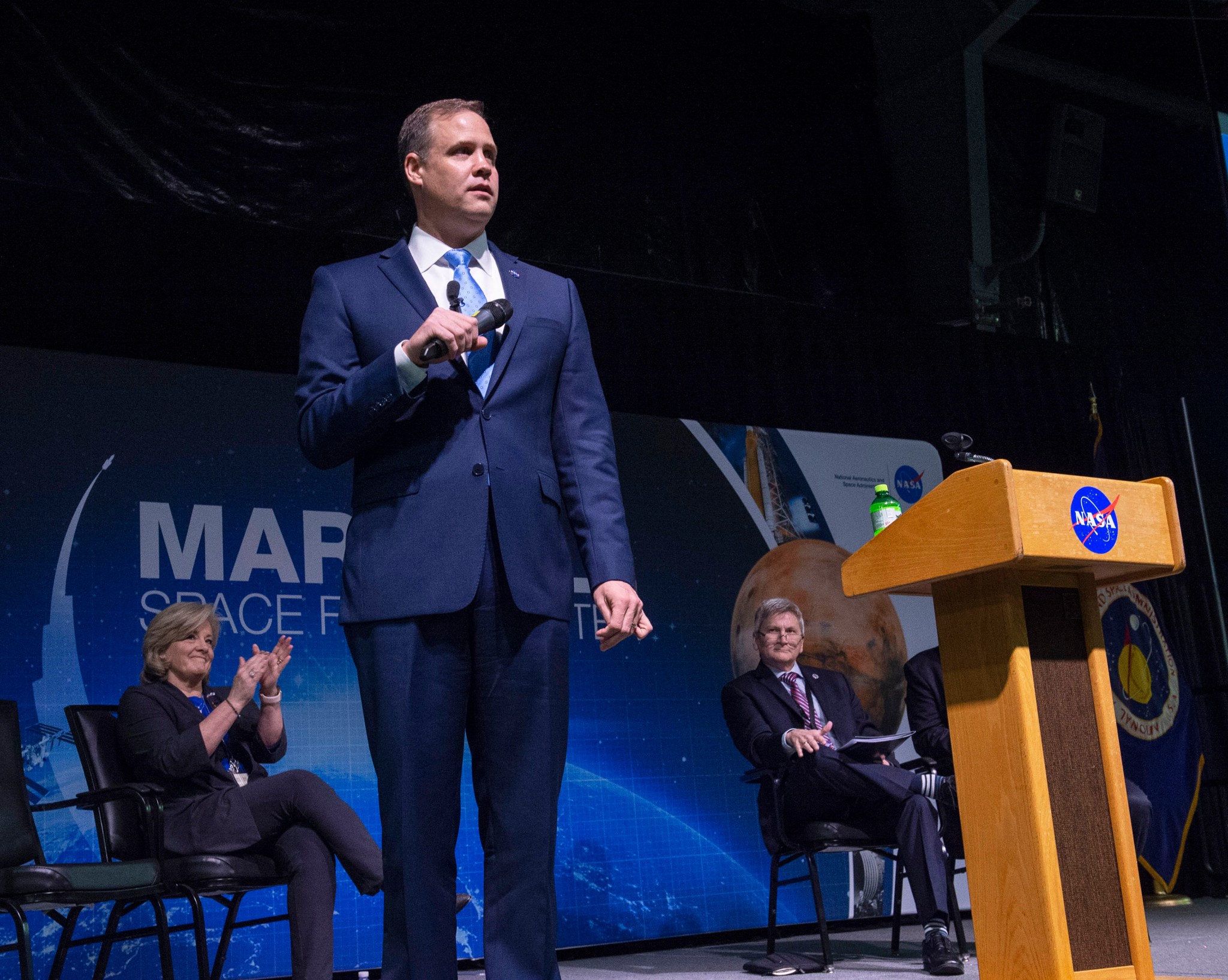
Bridenstine released a statement following Pence’s address. “It is the right time for this challenge, and I assured the Vice President that we, the people of NASA, are up to the challenge,” he said.
“We have laid out a clear plan for NASA’s exploration campaign that cuts across three strategic areas: low Earth orbit, the Moon, and Mars and deeper into space,” he continued. “There a lot of excitement about our plans and also a lot of hard work and challenges ahead, but I know the NASA workforce and our partners are up to it.”
Earlier, Marshall Director Jody Singer joined Bridenstine to assure team members of the center’s continuing, vital role in space exploration.
“Our workforce is so important,” Singer told the all-hands audience. “Our future is wide open when it comes to ability and skills. Everything you do makes this nation, this center and our world a better place.”
Bridenstine agreed. “What is done here is critically important to the agency. SLS and Orion are the backbone of our architecture to get to the Moon.”
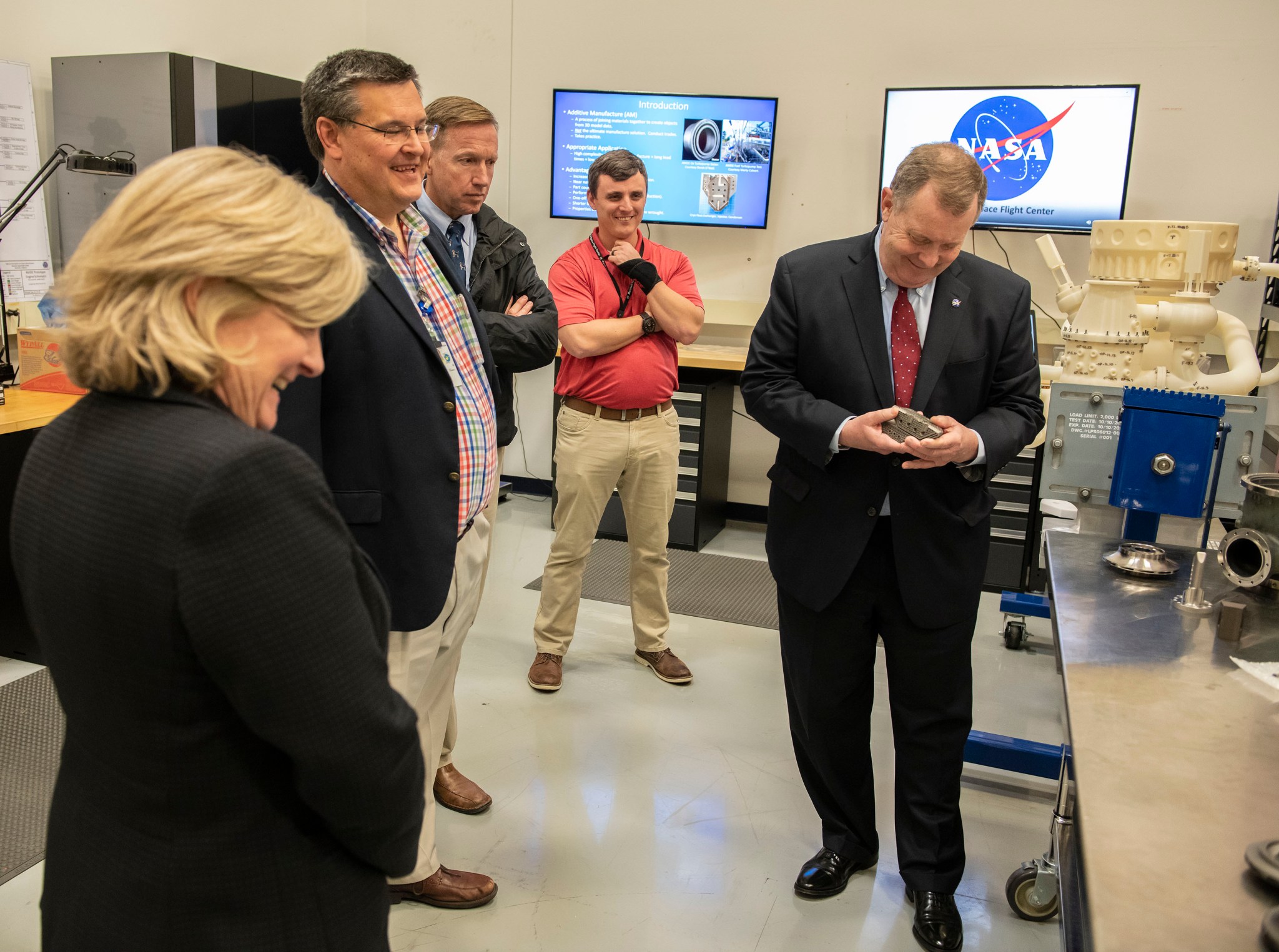
He cited strong bipartisan support in Congress for NASA’s mission, and noted the crucial role of SLS in flying the Europa Clipper mission to that Jovian moon in the 2020s, and its value to the Lunar Gateway, the proposed, permanent human presence on the Moon that will further scientific discovery and help pave the way to Mars.
As NASA leads humanity’s newest journey into the solar system, he said, “the human condition will be improved, as it has throughout [the agency’s] history.
“This time,” he said, “when we go to the Moon, we’re going to stay.” [Learn more about NASA’s Moon and Mars missions here.]
The week also marked the first visit to Marshall by NASA Deputy Administrator James Morhard, who toured Marshall test and manufacturing facilities March 25.
The National Space Council, established by presidential executive order in 2017, is chaired by the Vice President, and its membership includes the secretaries of principal cabinet departments in the executive branch, the director of National Intelligence, the chairman of the Joint Chiefs of Staff, the national security advisor and the administrator of NASA. Find complete video coverage of the latest National Space Council meeting here.
Smith, an ASRC Federal/Analytical Services employee, supports the Office of Strategic Analysis & Communications.
NASA Deputy Administrator Jim Morhard Visits Marshall
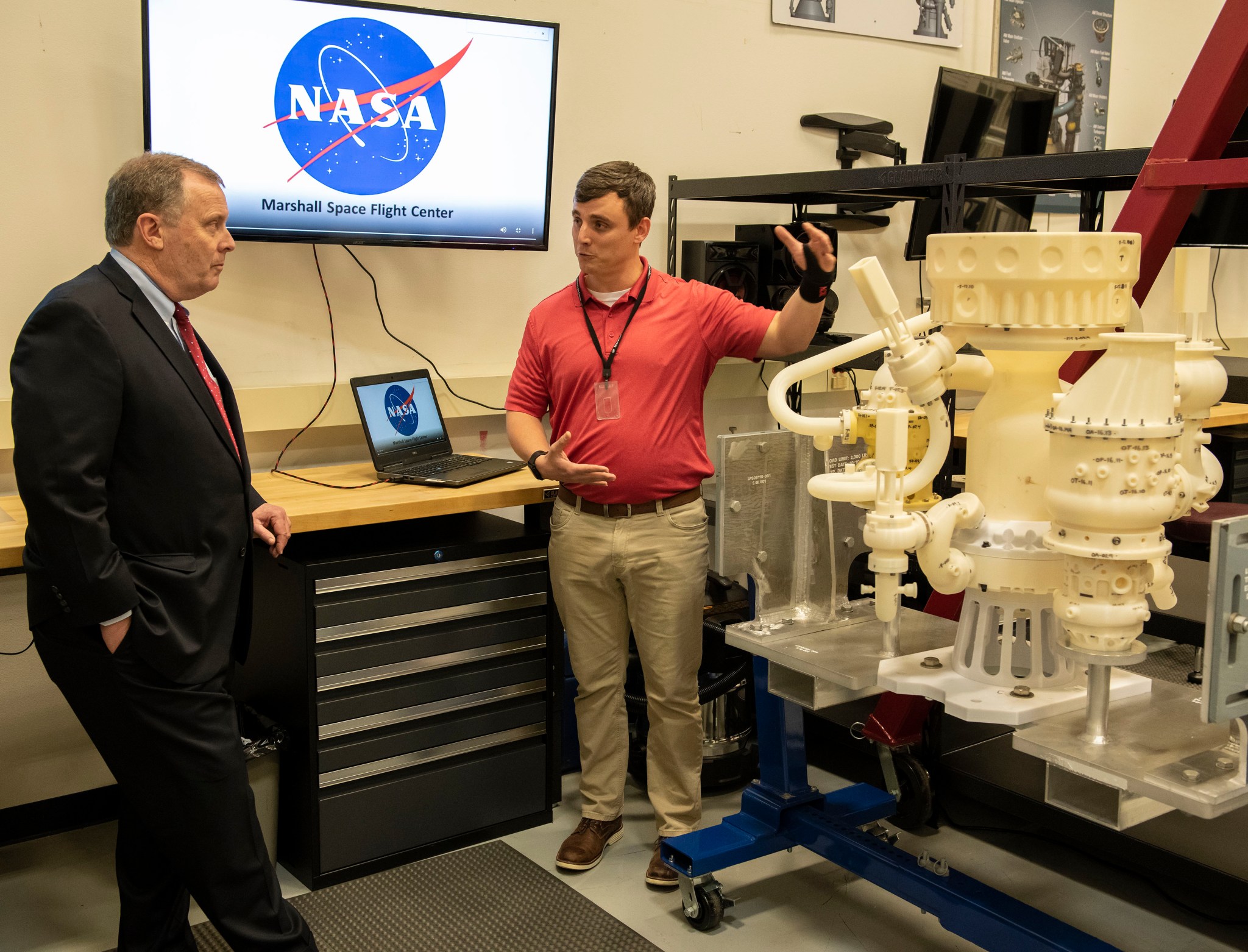
NASA Deputy Administrator Jim Morhard, left, visits the Combustion Lab at Marshall Space Flight Center on March 25, where Michael Allison shares the advancements being made in additive manufacturing of rocket engine parts at Marshall. Allison leads the assembly and integration lead for the MC2 engine model, shown here, which is an additively manufactured liquid engine designed and developed at Marshall. During his tour of the center, Morhard also saw the work being done by Marshall to advance deep space exploration at the Liquid Hydrogen Test Stand, Deep Space Habitat, Payload Operations Integration Center and the Systems Integration Lab. (NASA/Fred Deaton)
Marshall Team Finalizes Key Rocket Joint Assembly for Space Launch System
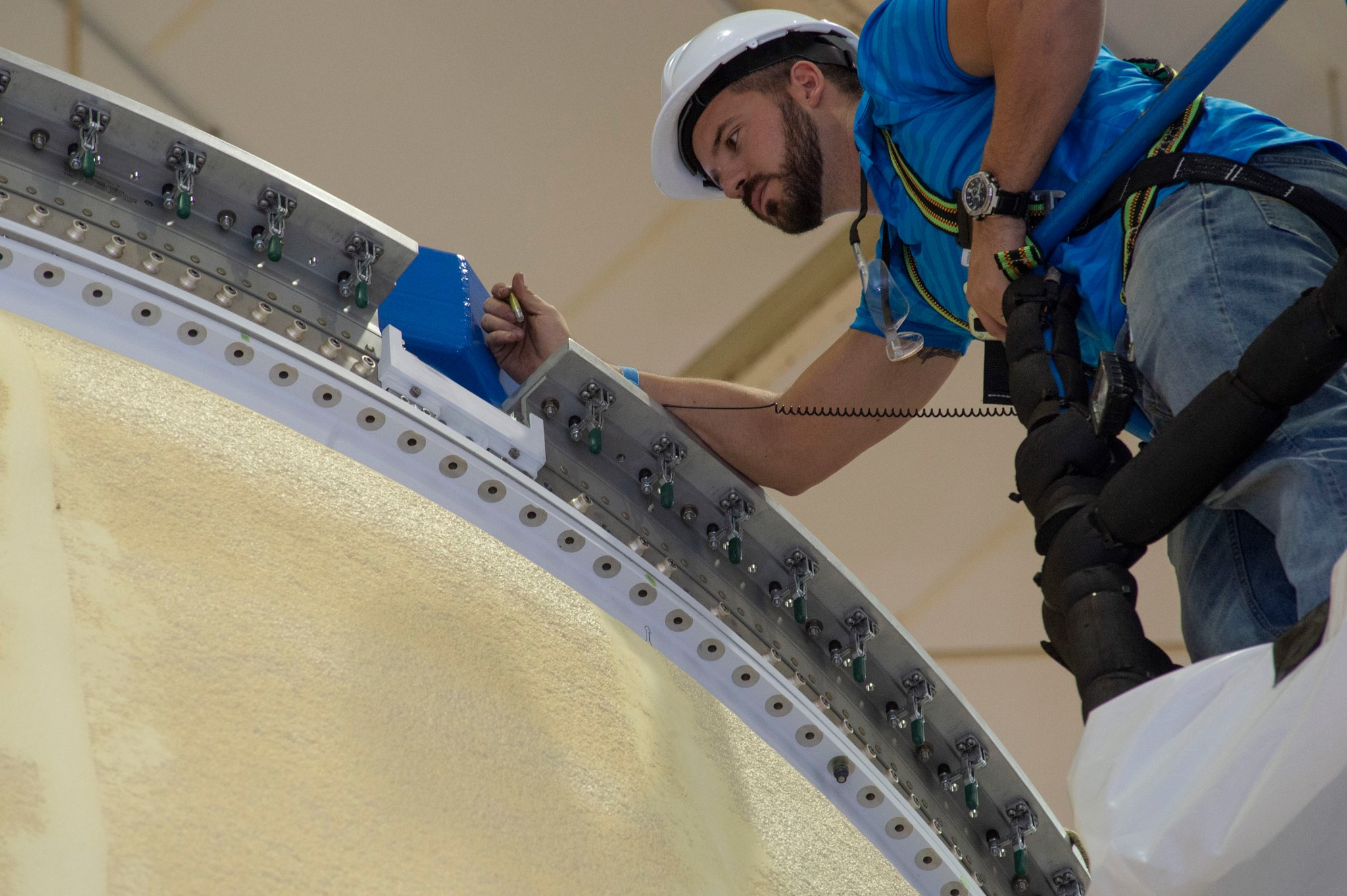
NASA’s Marshall Space Flight Center engineer Luke Johnson installs a new piece of hardware – a frangible joint assembly, commonly used to safely and efficiently separate stages during ascent and enable payload deployments – in the Space Launch System‘s launch vehicle stage adapter, or LVSA. It’s the latest step by NASA and its industry partners to ready the nation’s most powerful rocket ever for its first major test launch. The adapter connects the SLS core stage with its interim cryogenic propulsion stage, which will power the Orion crew vehicle to the Moon. Marshall workers next will ship the integrated hardware to NASA’s Kennedy Space Center, where technicians will stack the vehicle for final flight preparation. NASA’s SLS rocket and Orion spacecraft will pave the way for human missions to the Moon and Mars and groundbreaking new discoveries. Learn more about the frangible joint assembly and its role here. (NASA/MSFC/Emmett Given)
50 Years After Apollo, NASA Celebrates 25 Years of Student Rover Challenge
By Rick Smith
As NASA celebrates the 50th anniversary of the first Apollo Moon landing, this year the agency is also gearing up for its 25th year of challenging young innovators to design, build and drive lightweight vehicles inspired by the original lunar rovers. On April 12-13, high school and college student teams from around the world will take part in NASA’s Human Exploration Rover Challenge at the U.S. Space & Rocket Center.
The competition, organized by NASA’s Marshall Space Flight Center, honors a half-century of engineering ingenuity – from the groundbreaking Apollo lunar landings of the 1960s and 1970s to today’s preparations for bold new discovery missions to the Moon, Mars and beyond.
Nearly 100 teams are registered to participate, representing 24 states, the District of Columbia, Puerto Rico, and a record number of other countries, including Bangladesh, Bolivia, Brazil, the Dominican Republic, Ethiopia, Egypt, Germany, India, Mexico, Morocco and Peru.
“Furthering STEM education – science, technology, engineering and mathematics – remains vital to NASA’s mission,” said project manager Diedra Williams of Marshall’s Office of STEM Engagement, which organizes the event annually for NASA. “We seek to attract the best and brightest minds to help us fly new missions to space, explore the solar system and extend our scientific knowledge of the cosmos itself. Initiatives such as Rover Challenge are crucial to our continued success.”
NASA redesigned the event in 2018 to better reflect new planetary exploration challenges. Students must design the lightest possible rovers, each to be driven by two students — one male, one female — through a winding, half-mile course featuring 14 obstacles and five tasks, such as collecting samples, taking photos and planting a flag.
Each run is timed, with just six minutes of “virtual” oxygen available. Teams must decide which tasks and hurdles to attempt before the clock expires. Over the two-day challenge, they will strive to be among the top three finishers, vying for awards from NASA and corporate sponsors including best vehicle design and best rookie team.
Major corporate sponsors for the race are the Boeing Company; Jacobs Engineering; Polaris Industries; Lockheed Martin Corp.; and Northrup Grumman Corp., all with operations in Huntsville. Other contributors include the U.S. Space & Rocket Center, the City of Huntsville, Aerojet Rocketdyne, Science Applications International Corp., Davidson Technologies, the National Space Club, Teledyne Brown Engineering, Redstone Federal Credit Union, BWX Technologies, Leidos Inc., Integration Innovation Inc., Geocent LLC, MTS Inc., Aetos Systems, the University of Alabama in Huntsville, AI Signal Research Inc., the American Institute of Aeronautics and Astronautics-Greater Huntsville section, the Huntsville/Madison County Convention & Visitors Bureau, McDonald Scales Inc., Currie Systems, Kids In Space, MSB Analytics Inc. and Drury Inn & Suites, all of Huntsville; Cyient of Hyderabad, India; Corporate Office Properties Trust of Columbia, Maryland; the National Defense Industrial Association of Arlington, Virginia; and the Tennessee Valley chapter of the International System Safety Society.
The NASA Human Exploration Rover Challenge is sponsored by NASA’s Human Exploration and Operations Mission Directorate in Washington. It was launched in 1994 as the NASA Great Moonbuggy Race to commemorate the 25th anniversary of the Apollo 11 lunar landing. Just six college teams participated that first year. Expanded in 1996 to include high school teams, the race evolved again in 2014 into the Human Exploration Rover Challenge. Since its inception, more than 12,000 students have participated.
Smith, an ASRC Federal/Analytical Services employee, supports the Office of Strategic Analysis & Communications.
How NASA Engineer Julie Bassler Uses Her Farming Roots to Build NASA’s First Deep Space Rocket
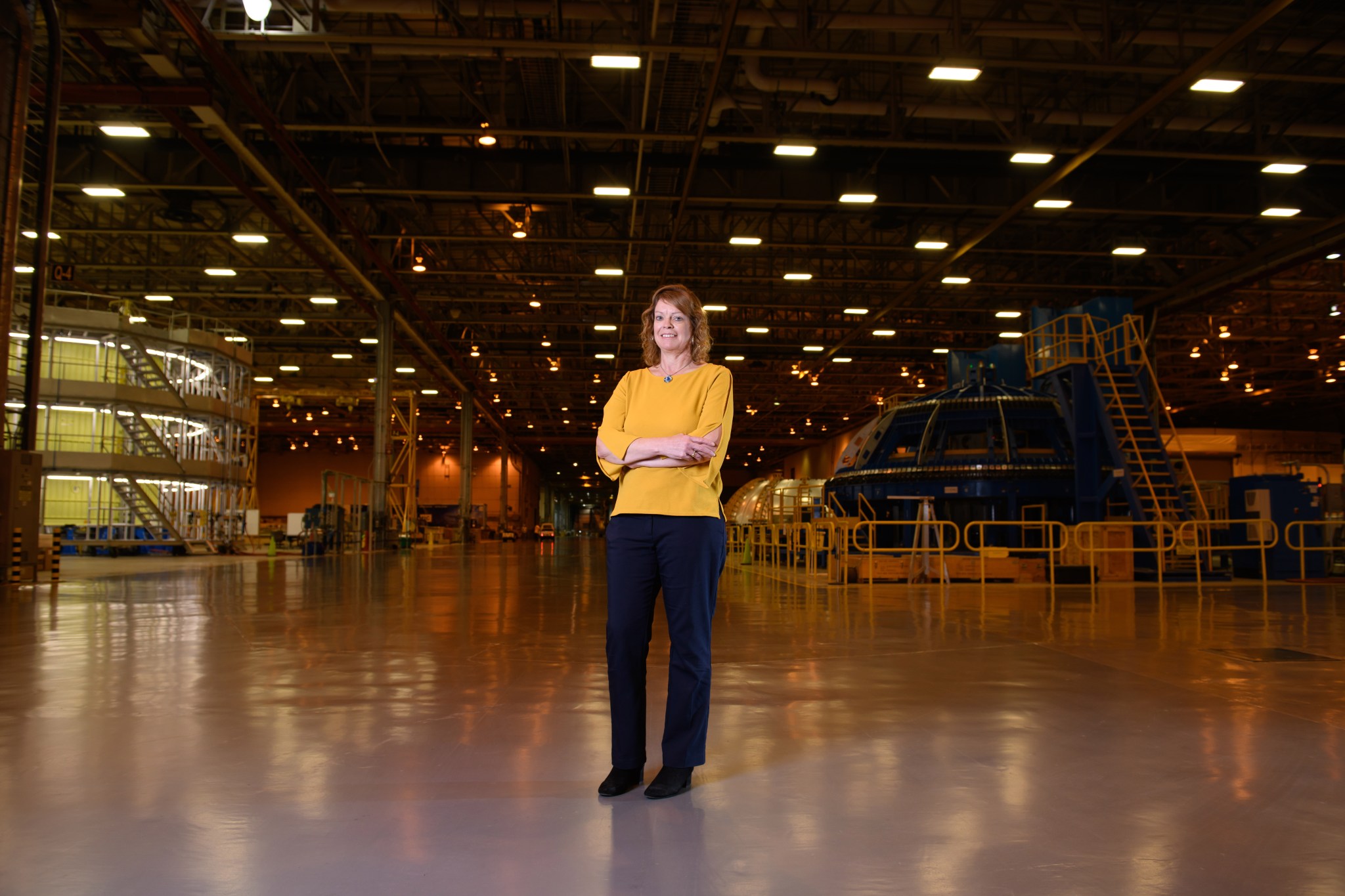
What do milking cows and baling hay have to do with rocket science? NASA engineer Julie Bassler says more than you think. Now the manager of the Stages Office for NASA’s Space Launch System (SLS) program at Marshall Space Flight Center, Bassler relates a lot of the work she does at NASA with the work she did on her family’s farm in Illinois. She says building America’s most powerful rocket is hard work and a genuine team effort. Bassler’s team oversees all facets of the core stage, including the refurbishing and activation of test stands, ground support systems and transportation equipment for the rocket’s structural test articles. She also works with teams across the nation to test and build the rocket at Marshall. Bassler’s personal experience spans the areas of human spaceflight, robotic missions, science payloads and technology development – cementing her as a leader, not just at Marshall, but for the SLS program. Her hard work and dedication were recognized earlier this month when she joined Marshall Director Jody Singer and other women leaders as featured guests on NBC’s Today Show for International Women’s Day. (NASA/Borderlon)
Marshall and UAH to Host NASA in the South Symposium March 28-29
On March 28 and March 29, NASA’s Marshall Space Flight Center History Office and the University of Alabama in Huntsville History Department will partner to host a symposium to address the impact of NASA on the Southern United States. The symposium will begin March 28 at UAH’s Student Services Building, followed by keynote presentations and panel discussions from historians from all around the South. For more information, including a complete schedule for the two-day event, please visit here. (NASA)
Honoring the Women of Marshall: Margaret W. ‘Hap’ Brennecke
By Brian Odom
A native of Emaus, Pennsylvania, Margaret W. “Hap” Brennecke was the first female welding engineer to work in the Materials and Processes Laboratory at NASA’s Marshall Space Flight Center. A true trailblazer in the field of aluminum alloys – a skill set critical to the success of the Apollo program – Brennecke spent her long career building large structures and breaking barriers in a previously male-dominated field.
Following completion of a bachelor’s degree in chemistry from Ohio State University in 1934, Brennecke conducted graduate work in metallurgy at the Carnegie Institute of Technology in Pittsburgh, Pennsylvania; the University of Pittsburgh; and the University of California in Los Angeles. She spent the following 22 years as a research metallurgist with the Aluminum Company of America Process Development Laboratory investigating new processes for using aluminum in large structures and developing new alloys. Over these years, she also embraced a love of travel, spending time in Russia in 1958, and taking trips aboard freighters travelling to and from bauxite mines on the Caribbean island of Trinidad.
It was World War II that provided Brennecke with the opportunity to move from chemistry to the field of welding and alloy fabrication. During the war, she worked to determine alloys and joining methods for aircraft, railroad equipment, bridges, pontoons and landing craft like those used during the 1944 Normandy invasion. Along with many other women in the era, Brennecke seized upon the opportunities offered by the rapidly expanding wartime economy and a shrinking male labor force which was fighting in Europe and the Pacific theaters. Discrimination on the basis of her gender followed Brennecke throughout her career. She noted that her nickname “Hap” allowed her to disguise her gender in written reports and correspondence beyond the laboratory.
In 1961, Brennecke joined Marshall in a position of welding expert, bringing with her a vast knowledge of aluminum alloys and Tungsten Inert Gas and Metal Inert Gas welding processes. Throughout the Saturn era, she was called upon by center management to make critical decisions on the selection of lightweight, high-strength metals and welding techniques for the huge Saturn stages. Specifically, Brennecke provided metallurgical engineering support for solving the problems of obtaining the required heat treatments, cold work and metallographic structure leading to high strength and reliability in thick aluminum welds of cryogenic fuel tanks. She also contributed to the important research efforts leading to optimal thermal-aging treatments for those high-strength aluminum alloys.
Brennecke published several articles during this period – one entitled, “Electron Beam Welding of 2219 Aluminum” in the January 1965 issue of Welding Journal and a NASA Technical Report on the “Evaluation of 2021 Aluminum Thermal Treatments” in May 1968. Brennecke held memberships in the American Society of Metals, American Institute of Mining and Metallurgy, American Welding Society and the Society of Aerospace and Materials Process Engineering. She was also a fellow in the Association for the Advancement of Science. Brennecke also held a 1957 Canadian patent for the aluminum alloy 7277.
Following the Saturn program, Brennecke was assigned to the Metallic Materials Division of the Marshall’s Materials and Processes Laboratory where she worked on metallic material and process selection and evaluation for Spacelab hardware and the solid rocket boosters for the Space Shuttle Program. She brought her immense experience to the selection of high strength steels, both in terms of data from experienced users to information on primary and secondary forming capabilities across the country. In 1974, Brennecke was a member of the committee responsible for rewriting the Military Handbook 5, the Metallic Materials and Elements for Aerospace Vehicle Structures – the most authoritative source for aerospace metals and alloys data.
Throughout her career, Brennecke fielded many cliched questions regarding women in the workplace. As part of an interview with the Marshall Star in 1962, she was asked, “How does a woman invade a so-called man’s world?” Her answer continues to ring true in the 21st century: “Establish yourself on the basis of what you can contribute, not of the basis of being a gal.”
Odom is the historian at NASA’s Marshall Space Flight Center.
Marshall’s Martin Weisskopf Talks Development and Discoveries of Chandra X-Ray Observatory
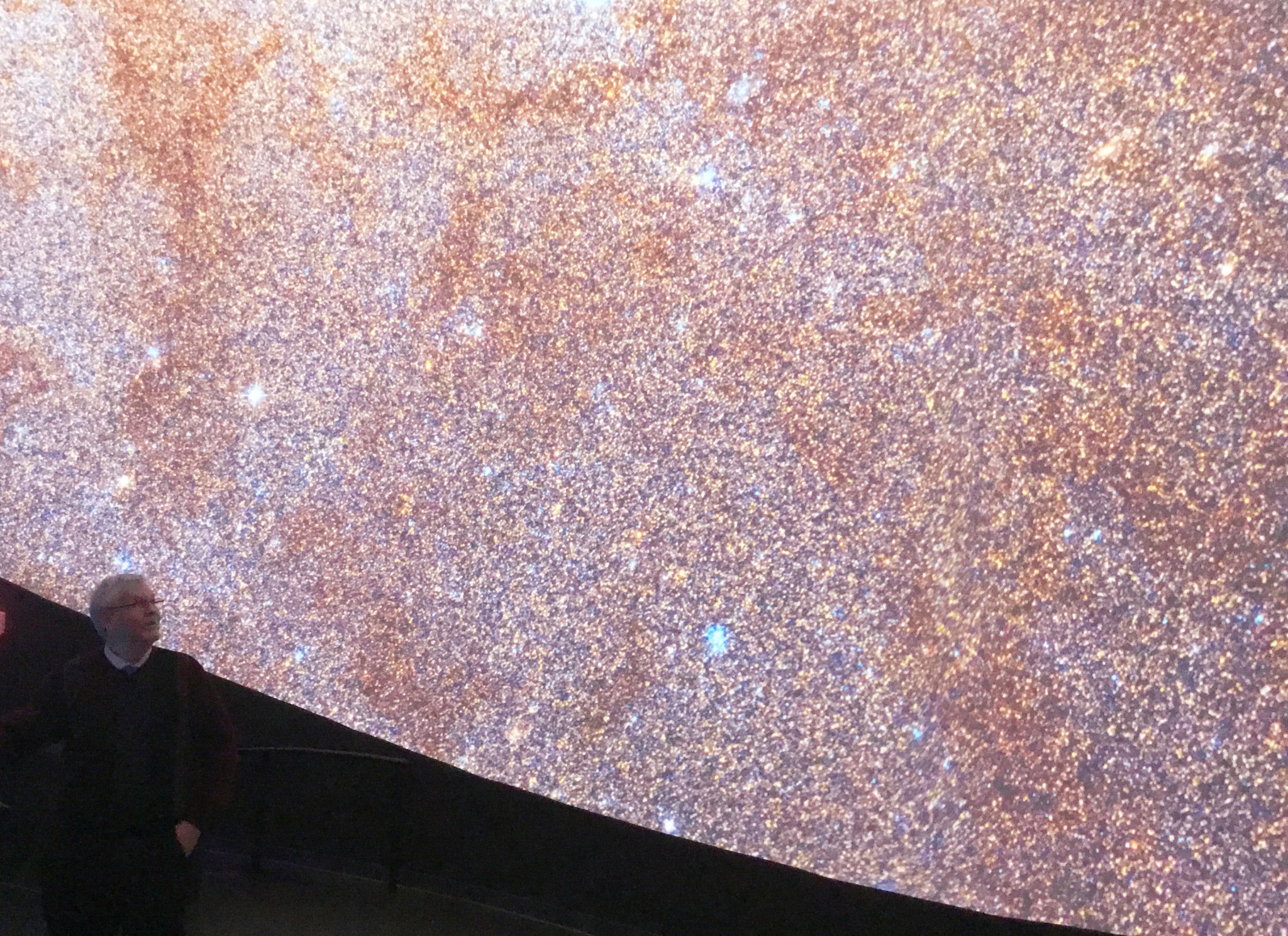
In the new Intuitive Planetarium at the U.S. Space & Rocket Center, NASA Marshall Space Flight Center’s Martin Weisskopf, project scientist for NASA’s Chandra X-ray Observatory, delivers a presentation March 26 about the many ways Chandra has changed scientists’ understanding of how the universe works. He also spoke about how Marshall managed Chandra’s successful development, which culminated in Chandra’s launch aboard the space shuttle Columbia in 1999. Weisskopf’s presentation was part of the Chandra Lecture Series. Click here to see images captured by Chandra during its 20 years of astronomical exploration that continues today. (NASA/Will Bryan)
OSIRIS-REx and Fermi Highlighted on ‘This Week @NASA’
New discoveries by NASA’s OSIRIS-REx spacecraft and NASA’s Fermi Gamma-ray Space Telescope are featured in “This Week @NASA,” a weekly video program broadcast nationwide on NASA-TV and posted online.
NASA’s OSIRIS-REx spacecraft, which will return a sample of near-Earth asteroid Bennu in 2023, has seen particle plumes erupting from Bennu – the first-ever close-up observations of particle plumes erupting from an asteroid’s surface. The spacecraft has also discovered Bennu’s surface is more rugged than expected – challenging the mission team to alter its flight and sample collection plans, due to the rough terrain. The OSIRIS-REx mission could help us learn more about the origins of our solar system and improve our understanding of asteroids that could impact Earth.
Astronomers have found a pulsar about 6,500 light-years away in the constellation Cassiopeia that is blazing through space at nearly 2.5 million miles an hour — so fast it could travel the distance between Earth and the Moon in just six minutes. The pulsar, dubbed PSR J0002, was discovered using NASA’s Fermi Gamma-ray Space Telescope and the National Science Foundation’s Karl G. Jansky Very Large Array. Pulsars are super dense, rapidly spinning neutron stars left behind when a massive star explodes. This one spins 8.7 times a second, producing a pulse of gamma rays with each rotation.
OSIRIS-REx is the third mission in NASA’s New Frontiers Program. Marshall Space Flight Center manages New Frontiers for the agency’s Science Mission Directorate. Marshall’s Colleen Wilson-Hodge is the principal investigator for Fermi’s Gamma-ray Burst Monitor instrument.
View this and previous episodes at “This Week @NASA” on NASA’s YouTube page.
This Week in NASA History: Installation of S-IC-D in Vertical Assembly Building at Michoud – March 24, 1965
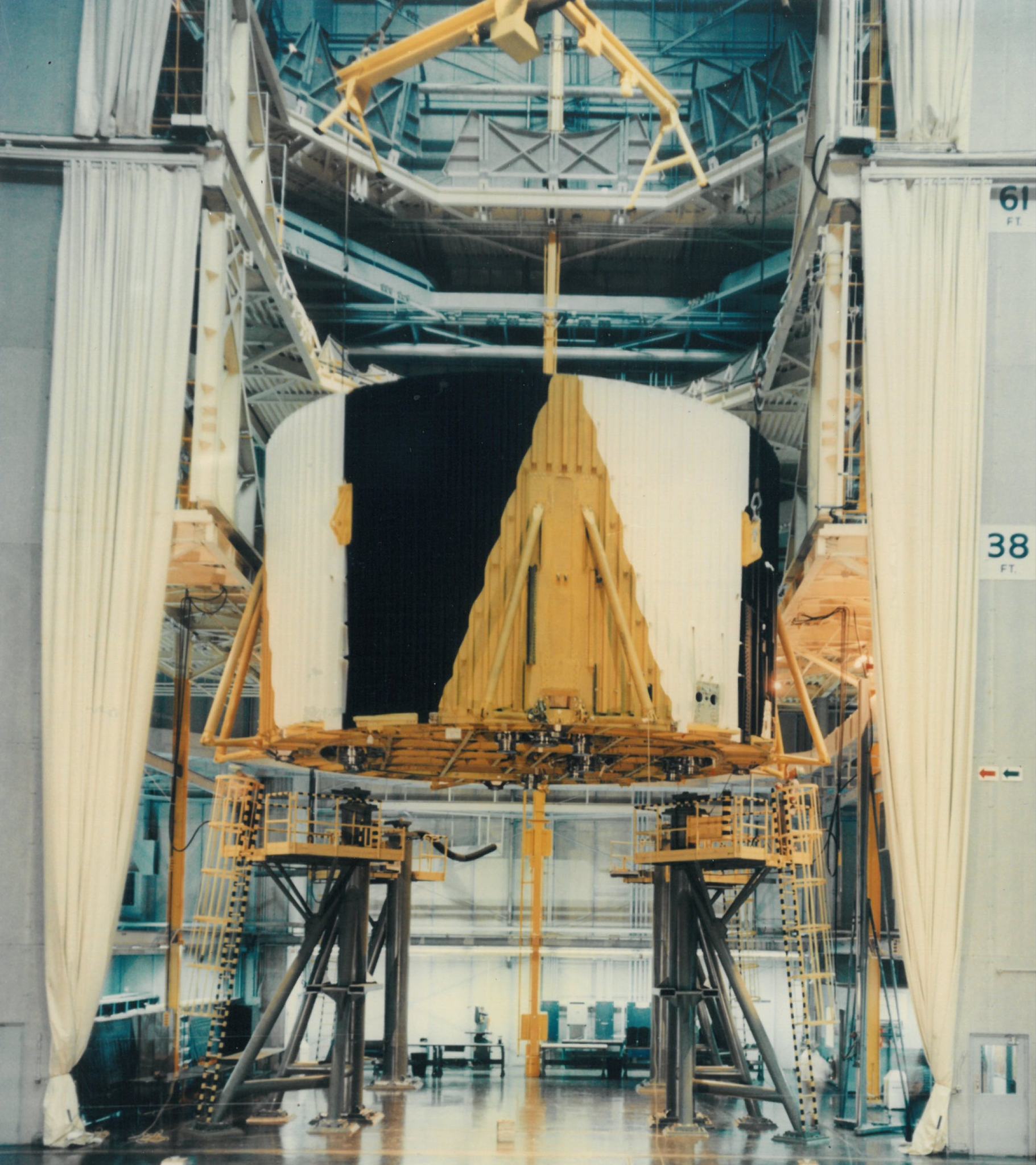
This week in 1965, technicians at NASA’s Michoud Assembly Facility installed the S-IC-D thrust structure in the Vertical Assembly Building. A component of the S-IC, or first stage of the Saturn V rocket, the thrust structure absorbed the forces created by the five F-1 engines and redistributed them into uniform loading around the base of the rocket. The thrust structure also provided support for the engines and engine accessories and miscellaneous equipment. S-IC-D was a flight model used for dynamic testing of the Saturn V S-IC stage. Here, the S-IC-9 – employed on Apollo 14 – is installed in the Vehicle Assembly Building. The Saturn V was designed at NASA’s Marshall Space Flight Center. From October 2018 through December 2022, NASA will mark the 50th anniversary of the Apollo Program that landed a dozen astronauts on the Moon between July 1969 and December 1972, and the first U.S. crewed mission – Apollo 8 – that circumnavigated the Moon in December 1968. The NASA History Program is responsible for generating, disseminating and preserving NASA’s remarkable history and providing a comprehensive understanding of the institutional, cultural, social, political, economic, technological and scientific aspects of NASA’s activities in aeronautics and space. For more pictures like this one and to connect to NASA’s history, visit the Marshall History Program’s webpage. (NASA)



























